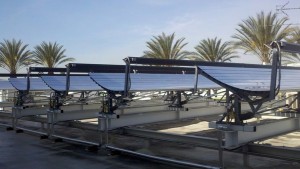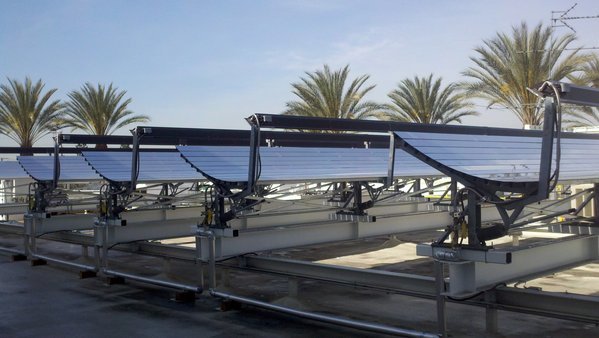Photovoltaic panels are noted for their ability to convert sunlight into electricity. But for a long time passive solar collectors have been used to provide hot water and heated air to residences and commercial businesses. Now a company in California is using the heat from solar to cool buildings. The company is Cogenra Solar. The product is called SunDeck. A 20 SunDeck modular system recently was installed on the roof of the Southern California Gas Energy Resource Center, a building that accommodates 700 staff and contains office space, workshops, an exhibit hall and conference rooms. The 20 unit installation generates 50.2 Kilowatts producing enough electricity to power the building, and enough heat to drive a single-effect absorption chiller to provide air-conditioning.

Solar panels are effective collectors of heat but not terribly efficient in generating electricity. At best panels convert at a rate of about 20%. But by building co-generation technology into the panels, energy conversion achieves 75% efficiency because the excess heat gets captured and stored as latent energy in liquid. That liquid then gets used to operate the cooling technology which is very similar to traditional absorption chillers except that no additional energy is required to create the cooling effect.
For Southern California Gas the ability to do co-generation using solar gives them a renewable energy solution that can help their customers dramatically reduce fossil fuel energy usage. And that translates to significant operational savings for both the utility and its customers.
Each SunDeck unit generates 10 tons of cooling , enough to cool two normal homes. The units lower greenhouse gas emissions by an estimated 50-60% from traditional photovoltaic systems. Payback ranges from three to five years.

















The rising cost of electricity and gas has thrown light on utilization of solar power at homes and offices. The basic strategy to make a solar power generator is to use a battery to store solar energy. You can charge this battery when solar power is available and then use the stored charge to run your appliances.
I thank you for the link to the article on building your own wind generator for residential use. The challenge for home owners is creating an off-the-grid solution that uses a combination of solar, wind and battery storage to provide 24×7 electricity, heating and air conditioning and do this economically. A $100 windmill solution that only works when the wind blows and isn’t integrated into an energy system such as the type Panasonic has recently announced will prove to be more a toy than a tool.
This is a fantastic example of convergent technology. Is there any indication that they have residential scale products?
An individual panel unit will generate over 1.4 kilowatts of power which is more than enough power for a single-family home. The design of their solar photovoltaic units which are arced require a flat surfaced area for installation. For most homes with slanting roofs I would think a flat-panel photovoltaic unit is more practical. The utility that is doing the pilot project has a different customer in mind because of scale. It wants to install commercial units to begin to get a return on investment. Residential presents significant challenges for utilities because every site may be different. For an installer the best approach to date has been working with a new developer of residential housing where standard configurations can be applied to many housing units. That also allows the utility more easily to plan for feed-in to the grid of excess power from the renewable source.